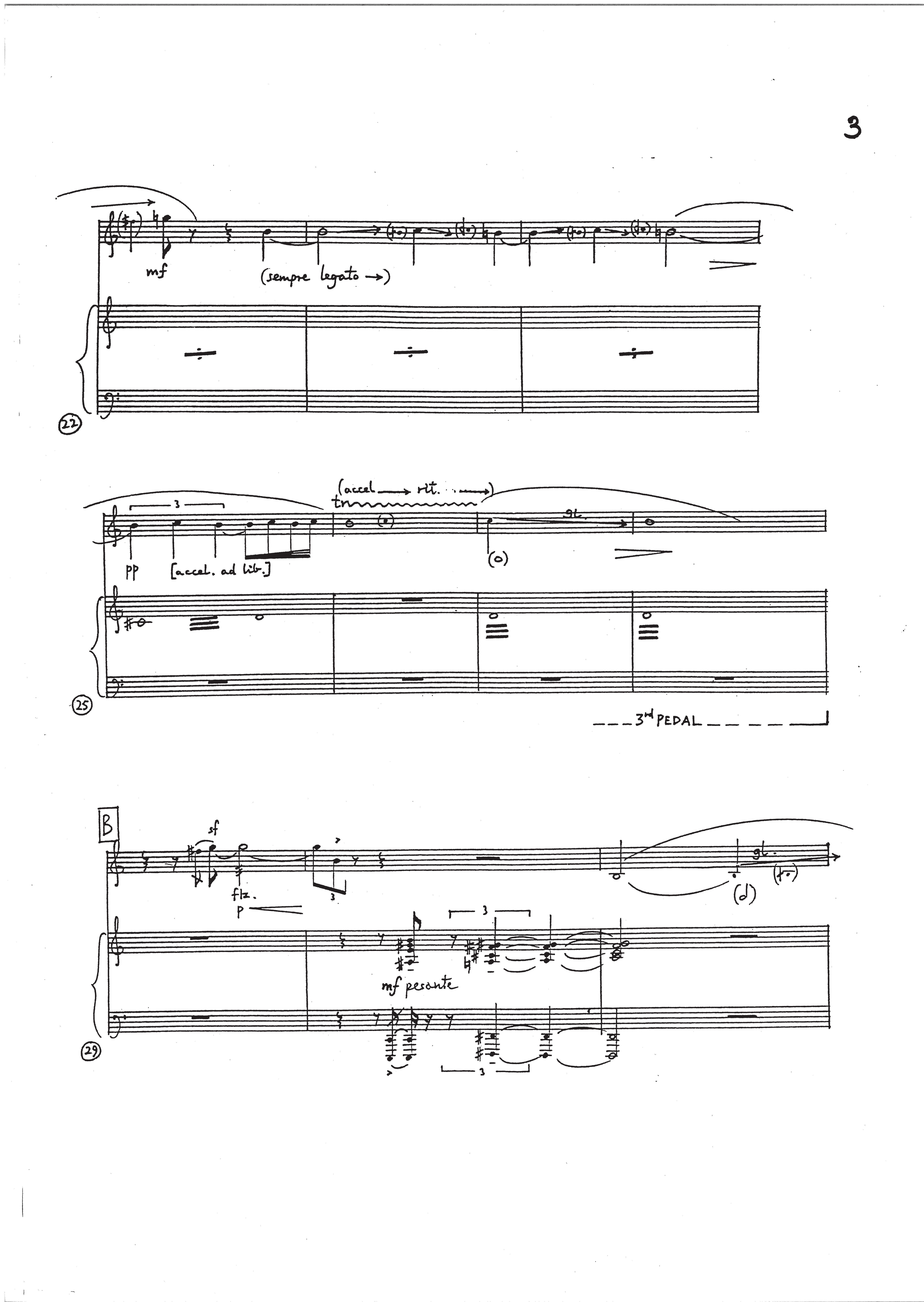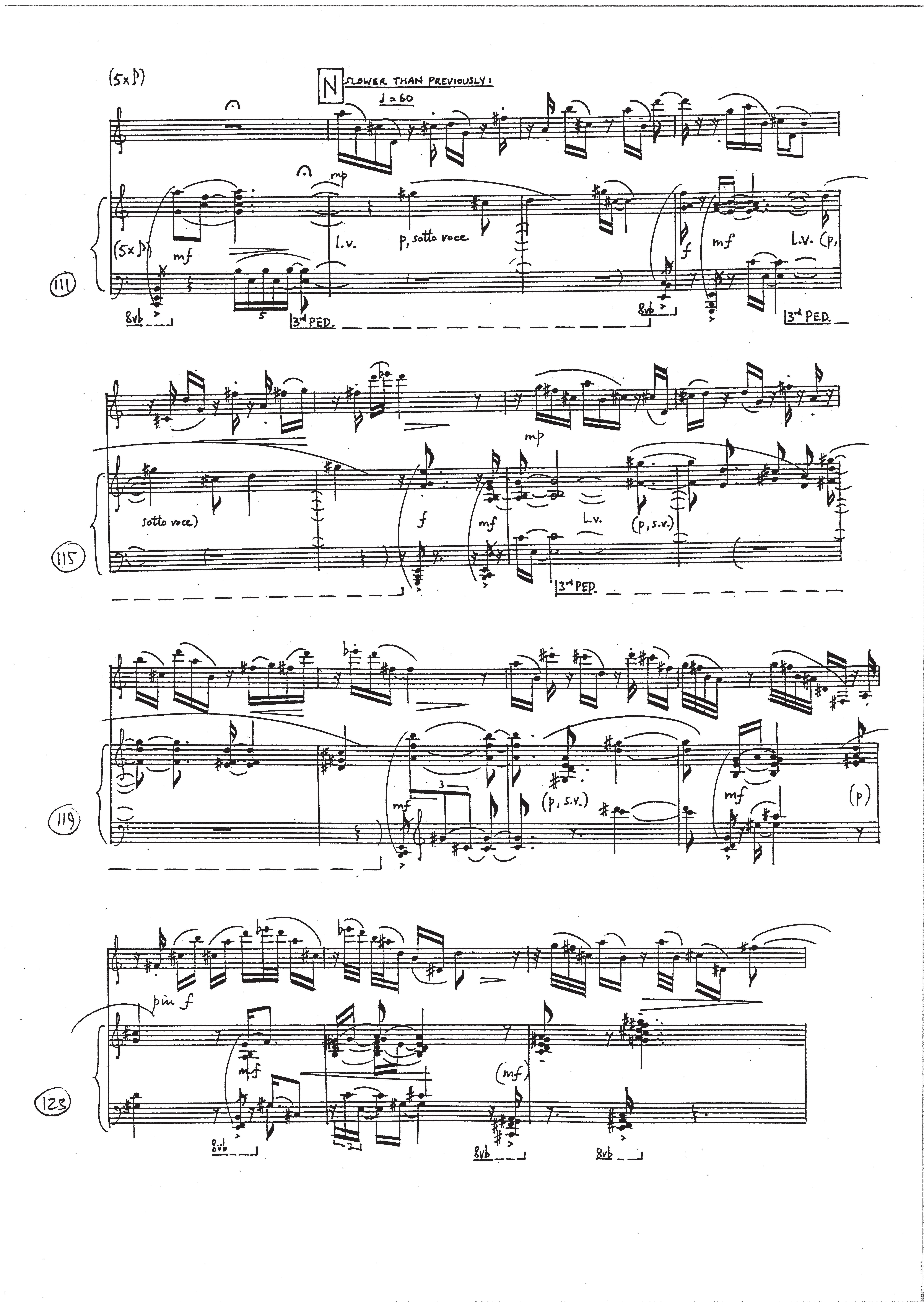HELLAWELL
High Citadels
for Clarinet and Piano



POD PETERS on demand
Piano
Strumming: the piano part up to letter B is entirely strummed, that is, the strings of two pitches (R. H.) and one pitch (L. H.) are brushed by forefingers in a tremolo, those pitches having been previously depressed and sustained on the 3rd (middle) pedal, which leaves all other strings unaffected.
Thimbles: from letter C the strumming is replaced by a more percussive playing, where precise rhythmic motifs are tapped on the strings, sustained on 3rd pedal as before. A metal thimble (fingerhut) on the two forefingers gives a clear tone, but it is important to strike the strings accurately (though very lightly). The same technique applies from letter E, though with greater rhythmic intensity. In bar 67, the L. H. forefinger with thimble plays the sf low C-sharp: the string should be marked.
String glissandi: from letter E the above rhythmic motifs alternate with R. H. forefinger strums upward, sustained by pedal. The exact range of these is subject to the available strings in a given piano, but their duration (quarter or eighth) is important.
Metal key*: In bars 68 and 70, a metal key held against low C/low D by the R. H. produces a harmonic. Strings should be marked.
Written-out accelerando: the score at letter K contains further explanation of this passage.
*The difficulty in executing such techniques here is really one of fluency, especially given variations in the type of piano. In bars 67–72, for example, a wide rubato can be employed to enable smooth transition of events, in keeping with the opening marking (bar 1).
Clarinet
Grace notes: In the opening bars and at letter K, the clarinet is required to repeat a note and its acciaccatura while both note and grace note are much extended. This amounts to a long rallentando, which at letter K1 is then reversed. In bar 9, the main (stressed) note comes before the (unstressed) grace note.
Glissandi: A variety of glissandi is found in the first section, both narrow (e.g. 1/2step, bars 3–6) and wide (bar 47, where it extends upwards ad lib.). A glissando is ‘articulated’ at bars 13 and 18 by accelerando tonguing.
Almost all my works are responses to, and evocations of, landscape. This piece is more explicitly so, starting from contemplation of three sorts of high places – one natural, one man-made and one imaginary
First, are the clustering rocks on a high mountain ridge, glimpsed from below through swirling cloud. Second, is Arcosanti, Paolo Soleri’s experiment in urban planning clinging to the high desert of Arizona – half medieval hill-town, half space-station. Arcosanti, where an annual young composers’ forum is held, explores an alternative to the sterile assumptions that have created the suburban nightmare around our modern cities. Third, is the sky itself. Watching a Northern night-sky of amazing clarity, I imagined the vast canopy of lights as actually a city I was viewing from above – the stars the city-lights of a million dwellings.
The piece is thus in three phases, covering a variety of states in a short time. This variety, and the explicit concern with landscape, make me think that the work is like an aerial viewing: in just a few minutes the spectator passes over new terrains that are very different from the starting point. The first section is the broadest, a long scena for clarinet over a piano-string drone. The second is much busier, interlocking sections of activity with broad skyscapes. In the final coda passage, pinpoints of clustered sound punctuate the darkness. The piece is dedicated to Paolo Soleri.
Piers Hellawell 1994
to Paolo Soleri
for Clarinet and Piano

Piers Hellawell (1994)

















Piers Hellawell (b. 1956) has worked with leading artists such as the London Symphony Orchestra, Schubert Ensemble, Dame Evelyn Glennie and the Hilliard Ensemble, who toured his Hilliard Songbook pieces worldwide. Orchestral works include Cors de chasse (for Håkan Hardenberger, Jonas Bylund and the Philharmonia Orchestra) and the BBC commission Dogs and Wolves (2006), while Syzygy was premiered in 2013 by the Stockholm Chamber Brass/Swedish Chamber Orchestra. 2016 saw Hellawell’s Wild Flow commissioned for the BBC Proms, and a UK tour of Up by the Roots – a collaboration with poet Sinéad Morrissey – as well as a composer feature at Detroit’s Great Lakes Festival. Hellawell has been Professor of Composition at Queen’s University of Belfast since 2002, and has spoken widely on issues of music and cultural ownership as Gresham Professor of Music in London, 2000–2003.
Piers Hellawell (*1956) hat mit führenden Interpreten wie dem London Symphony Orchestra, dem Schubert Ensemble und Evelyn Glennie zusammengearbeitet. Das Hilliard Ensemble brachte sein Hilliard Songbook weltweit zur Aufführung. Für Orchester enstanden u. a. Cors de chasse (für Håkan Hardenberger, Jonas Bylund und das Philharmonia Orchestra), das BBC-Auftragswerk Dogs and Wolves (2006) sowie das 2013 vom Stockholm Chamber Brass/Swedish Chamber Orchestra uraufgeführte Syzygy. 2016 folgten Wild Flow für die BBC Proms, Up by the Roots – ein Gemeinschaftswerk mit der Dichterin Sinéad Morrissey, das in ganz Großbritannien auf Tournee ging – sowie ein Komponistenporträt beim Great Lakes Festival in Detroit. Seit 2002 ist Hellawell Professor an der Queen’s University in Belfast. Als Inhaber der Londoner Gresham-Professur für Musik setzte er sich 2000–2003 mit Fragen des kulturellen Eigentums in der Musik auseinander.